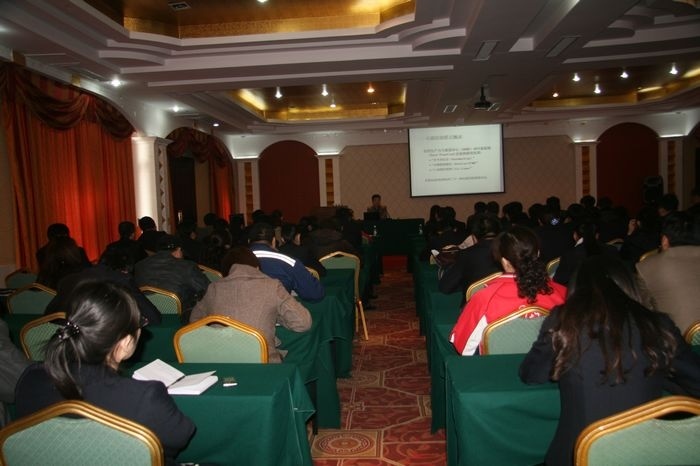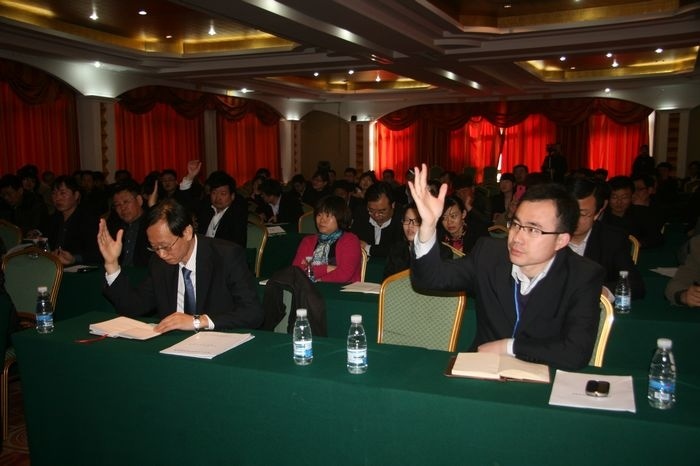Huaxia Group held training on enterprise performance management model
Release time:
2018-04-27
据了解,绩效管理模式源自美国波多里奇奖评审标准,以顾客为导向,追求绩效的管理理念,体现了当今世界现代管理的理念和方法,是当前国际上广泛认同的一种组织综合绩效管理的有效方法和工具。 绩效的突出特点为:一是从产品、服务质量扩展到经营的质量。绩效标准中所说的质量内涵不仅局限于产品、服务质量,而是强调"大质量"的概念,由产品、服务质量扩展到工作、过程、体系的质量,进而扩展到企业经营的质量。产品、服务质量追求的是满足客户需求,赢得顾客和市场;而经营质量追求的是企业综合绩效和持续经营的能力。产品、服务质量好,不等于经营质量一定好,但产品、服务质量是经营质量的核心和底线。卓越绩效标准对企业从领导、战略、以顾客和市场为中心,测量分析和知识管理、以人为本、过程管理等方面提出了系统的要求,最终落实到企业的经营结果,是当今国际上公认的经营质量的标准,即TQM标准。二是聚焦企业的经营结果。卓越绩效标准强调结果导向,非常关注企业经营的绩效,"经营结果"一项在标准满分1000分中占到40%--50%。但标准中所指的"绩效"不只是利润和销售额,其中还包括了顾客满意、产品和服务、财务和市场、人力资源、组织有效性和社会责任等6个方面的综合绩效,充分考虑到企业的顾客、股东、员工、供应商和社会等相关方的利益平衡,以保证企业的可持续发展。三是关注比较优势和竞争能力的提升。实施卓越绩效标准的目的,在于提升企业的竞争能力,因此特别关注企业的比较优势和市场竞争力。企业在进行战略策划时,注重对市场和竞争对手的分析,以制定出超越竞争对手、能在市场竞争中取胜的战略目标和规划;在评价绩效水平时,不仅要与自己原有水平和目标比,而是强调与竞争对手比、与标杆水平比,在比较中识别自己的优势和改进空间,增强企业的竞争意识,提升企业的竞争能力。四是提供了可操作的管理方法。卓越绩效标准不仅反映了现代经营管理的先进理念和实现卓越绩效的框架,而是提供了许多可操作的管理方法,有助于提高企业管理的有效性和效率。例如:提高组织领导力的方法;基于全面分析的战略制定和展开方法;评价绩效水平和组织学习的"水平对比法";从市场和顾客的角度评价企业产品、服务质量的"顾客满意度、顾客重视度测量的"方法;确定企业关键绩效指标体系的方法;员工绩效管理的"平衡积分卡";促进员工绩效提高的"员工权益和满意度测量"等方法。五是强调持续改进、提高成熟度。卓越绩效标准不同于ISO9000质量管理体系,不是一个符合性标准,而是一个成熟度标准。它不是规定企业应达到某个水平,而是引导企业持续改进,认识到哪些工作需要进行整合、改进和创新,发现可以改进的空间。一个卓越的企业不是没有问题的企业,而是一个能不断持续进行改进,不断完善和趋于成熟,永无止境地追求卓越的企业。 通过两天系统详细的绩效管理培训,使集团相关人员对绩效管理模式有了更深入的了解,尤其是将卓越绩效模式的相关理论与公司实际情况相结合,更好的将追求卓越绩效模式的理念全方位的渗透到企业的各个部门,为今后集团相关管理工作的有效实施提供了新思路新方法,为进一步推进企业走精细化管理道路,加快企业质量管理水平的不断提高起到了积极的推动作用。 为提升企业质量管理水平,夯实企业质量建设基础,4月7日至8日,华夏集团在华夏会馆11号楼会议室举办了为期两天的企业绩效管理模式培训班,集团中层以上领导干部全部参加了此次培训。 此次培训特邀中国质量协会理事、全国质量奖评审员、山东省省长质量奖评审组长李韶南老师主讲,采取多媒体授课和现场互动相结合,案例分析和PEST分析等练习相结合,重点讲授了企业亟需了解掌握的《绩效评价准则》及《绩效评价准则实施指南》等国家标准。


It is understood that the performance management model is derived from the evaluation standard of the American Bordridge Award. It is customer-oriented and performance-seeking management concept, which embodies the concept and method of modern management in the world today. It is an effective method and tool of organizational comprehensive performance management widely recognized in the world.
The outstanding characteristics of performance are: first, from the quality of products and services to the quality of management. The quality connotation mentioned in the performance standard is not limited to the quality of products and services, but emphasizes the concept of "great quality", which extends from the quality of products and services to the quality of work, process and system, and then to the quality of enterprise management. The pursuit of product and service quality is to meet customer needs and win customers and the market, while the pursuit of business quality is the comprehensive performance of enterprises and the ability to continue to operate. Good product and service quality does not mean that business quality is necessarily good, but product and service quality is the core and bottom line of business quality. The performance excellence standard puts forward systematic requirements for enterprises from the aspects of leadership, strategy, customer and market-centered, measurement analysis and knowledge management, people-oriented, process management, etc., and finally implements the business results of enterprises, which is the internationally recognized standard of business quality, namely TQM standard. The second is to focus on the business results of the enterprise. The excellent performance standard emphasizes result orientation and pays close attention to the performance of enterprise operation. The "operation result" accounts for 40%-50% of the standard full score of 1000. However, the "performance" referred to in the standard is not only profit and sales, but also includes the comprehensive performance of customer satisfaction, products and services, finance and market, human resources, organizational effectiveness and social responsibility, taking full account of the balance of interests of customers, shareholders, employees, suppliers and society, so as to ensure the sustainable development of the enterprise. The third is to pay attention to the improvement of comparative advantage and competitiveness. The purpose of implementing performance excellence standards is to enhance the competitiveness of enterprises, so special attention is paid to the comparative advantage and market competitiveness of enterprises. When carrying out strategic planning, enterprises pay attention to the analysis of the market and competitors, so as to formulate strategic objectives and plans that surpass competitors and can win in market competition. When evaluating performance level, enterprises should not only compare with their original level and objectives, but also emphasize the comparison with competitors and benchmarking level, identify their own advantages and improvement space in comparison, and enhance the competitive consciousness of enterprises, enhance the competitiveness of enterprises. Four is to provide operational management methods. The standard of performance excellence not only reflects the advanced concept of modern management and the framework for achieving excellent performance, but also provides many operational management methods to help improve the effectiveness and efficiency of enterprise management. For example: methods to improve organizational leadership; strategy formulation and deployment methods based on comprehensive analysis; "level comparison method" to evaluate performance level and organizational learning; "customer satisfaction and customer attention measurement method" to evaluate enterprise products and service quality from the perspective of market and customers; methods to determine enterprise key performance indicator system; "balanced scorecard" for employee performance management "; methods such as" employee equity and satisfaction measurement "to promote employee performance improvement. The fifth is to emphasize continuous improvement and improve maturity. The performance excellence standard is different from the ISO9000 quality management system. It is not a conformity standard, but a maturity standard. It is not to stipulate that the company should reach a certain level, but to guide the company to continuously improve, recognize what work needs to be integrated, improved and innovated, and find room for improvement. An excellent enterprise is not a problem-free enterprise, but an enterprise that can continuously improve, constantly improve and mature, and pursue excellence endlessly.
Through the two-day systematic and detailed performance management training, the relevant personnel of the group have a deeper understanding of the performance management mode, especially by combining the relevant theories of the excellent performance mode with the actual situation of the company, the concept of pursuing the excellent performance mode can be better penetrated into all departments of the enterprise, which provides new ideas and new methods for the effective implementation of the relevant management work of the group in the future, in order to further promote the enterprise to take the road of fine management, accelerate the continuous improvement of enterprise quality management level has played a positive role in promoting.
In order to improve the level of enterprise quality management and consolidate the foundation of enterprise quality construction, Huaxia Group held a two-day training course on enterprise performance management mode in the conference room of Building 11 of Huaxia Guild Hall from April 7 to 8. All the leading cadres above the middle level of the group participated in the training.
This training specially invited Mr. Li Shaonan, director of the China Quality Association, reviewer of the National Quality Award and reviewer of the Shandong Provincial Governor's Quality Award, to give a lecture. The training focused on the national standards such as "Performance Evaluation Criteria" and "Implementation Guidelines for Performance Evaluation Criteria" that enterprises urgently need to know and master by combining multimedia teaching with on-site interaction, case analysis and PEST analysis.

Tag:
Next Page
RELATED INFORMATION


